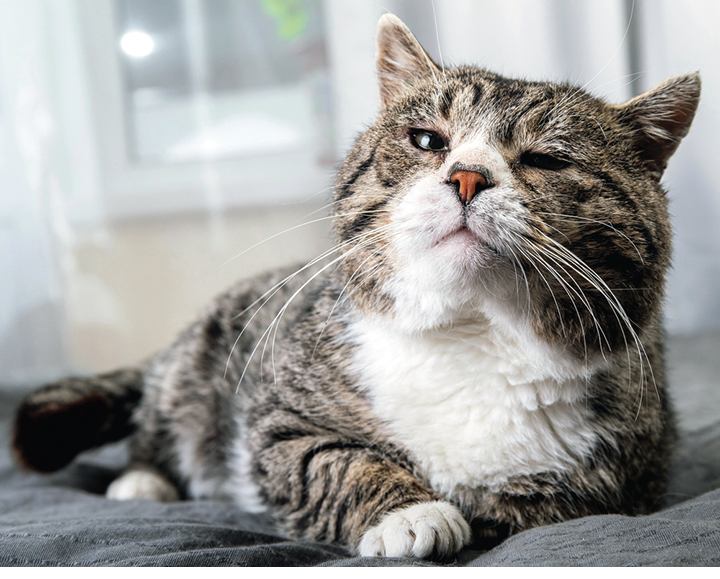When we hear someone tell us our senior cat “looks really good for her age,” we might want to give some thought to that qualifier “for her age.” It’s important.
While aging is not a disease, it does come with inevitable physiological changes that affect not only the way our cat looks, but the way her body functions as well. It can be easy to brush off physical and mental changes as part of growing older, but the aging process naturally makes our cat more prone to disease. To increase our cat’s longevity and quality of life, we need to discriminate between natural aging and early signs of illness so we can intervene early and provide veterinary and nutritional support.
Cats make this difficult, of course, hiding mild signs until they hit a threshold where they can no longer function properly. This often makes it seem like a disease came on suddenly, when the truth may be that it’s been insidiously coming on for months.
Normal general aging events include:
- cognitive changes similar to people
- decreased wound healing
- diminished ability to digest nutrients
- decreased kidney size and blood flow
- hearing loss
- joint cartilage deterioration
- lowered immunity
- muscle loss (sarcopenia)
- thin, fragile skin
- vision changes
Signs not associated with normal aging that may indicate disease include:
- decreased appetite
- difficulty breathing
- excessive thirst and urination
- inappropriate elimination (urinating/defecating outside the box)
- lameness
- lumps/bumps/swellings
- nighttime yowling/wandering/pacing/withdrawal from family
- oral pain/odor or difficulty eating
- painful urination/defecation
- persistent vomiting/diarrhea
- weight loss
- significant lethargy
If your cat shows any of these indicators, see your veterinarian. Be prepared to provide a thorough and complete history, which will help your veterinarian immensely in diagnosing and treating your cat. Your veterinarian will do a physical exam, including neurological and orthopedic assessment, assessing your cat’s overall condition and weight, and noting overall muscle loss.
Appropriate diagnostic tests may include blood work, urinalysis, urine culture, chest/abdomen x-rays, and abdominal ultrasound. Where you go from there depends on what is found with the preliminary testing. The most common geriatric cat diseases are chronic kidney disease, hyperthyroidism, diabetes mellitus, cancer, dental disease, osteoarthritis, and cognitive decline (like Alzheimer’s in people).
Assisting an aging cat nutritionally, medically, physically, and environmentally enhances her health, longevity, and quality of life. Partnering with your veterinarian to provide the best nutrition and care enhances your relationship with your cat and keeps her going strong for as long as possible. Earlier detection of disease is better for your cat, for you, and for your wallet.
What You Can Do for Your Aging Cat
- Stick to senior wellness exams twice a year. A lot can change in six months during this life stage.
- Nutrition is critical. Choose a highly digestible, good-quality diet formulated specifically for senior cats.
- Make life easier. Consider an easily accessible litterbox with low sides on every level of your home. Food and water bowls on every floor help, too, and night lights throughout your home will help your geriatric cat navigate at night.
- Joint supplements with glucosamine/chondroitin combinations can keep your aging cat’s joint cartilage healthier. The omega fatty acids found in fish oil can also support joint health and provide general anti-inflammatory benefits that may help stave off cognitive dysfunction.
- Check your older cat’s mouth regularly for odor or bleeding and note any discomfort associated
with eating. - Since senior cats can find the physical act of self-grooming difficult, schedule for regular combing, brushing, and claw trimming.




